
[Updated with analysis and comments]: The chasing start in Camp Norway today featured a test of the new Runners Choice spreading method. With GPS-tracking available – it is very interesting to see how it worked out.
In the mens course, there were three legs with “Runners Choice” – in which the runners had to choose which variant to take without knowing what the other runners did. I am not sure exactly how the choice was made, but I will get information about that and update this article. The runners made their choice by punching the map “the old-fashioned way” at the control where the Runner’s Choice segment started (i.e. at the 5th control, 8th control and 11th control for the men)
First test in good start field
– It split the field a few times, but it did not give big differences
The runners see some potential in the spreading method, but don’t yet see it as the ultimate spreading method which one is searching for to make it possible to have a chasing start in the future WOC program.
– First time running “Runners Choice” today. If the goal is to spread the runners, it needs more development, so far not better than the butterflies, Olav Lundanes comments on Twitter.
Other runners commented that it was possible to see which control other runners choose based on the direction the runners in front left the control. However, it seems like a quite positive first test in a quite good start field.
– It split the field a few times, but it did not give big differences, Carl Waaler Kaas commented.
Illustrations
Below I have set up illustrations for each of the three segments in the mens class with Runners Choice. A full analysis can only be made with the split times – this is just a qualitative analysis based on inaccurate GPS-times. A short discussion of each of the Runner’s Choice legs:
- Control 5-7: Very good spreading to the three different alternatives. The fastest times are run in alternative A, but B is very close. Alternative C seems to be slower – more than 30 seconds for the best split times, but it also looks like not many of the best choose this option. This is of course a challenge in an analysis.
- Control 8-10: Only alternative A and B are used (except for a single runner for alternative C). Alternative C seems to be clearly better – the majority of good times being run here.
- Control 11-13: Again only two alternatives used – B and C (and a single runner at alternative A). However, alternative A might well be quite good, as the time run there is not that bad. Of the other two alternatives, it seems like B is faster – and also with more variance in the split times for variant C – probably because C is more challenging orienteering technically.
Overall there is good spreading into two variants for two of the Runners Choice segments and into all three variants for the third segment. Thus it seems like the spreading method works well in the sense that it spreads runners based on the runners’ own choice. I have not done any analysis on if the spreading method really splits up runners – of course that is the most interesting subject here (maybe Martin at O-zeugs want to take a look if we get the splits times). However, the first part of the mission – spreading the runners – was accomplished. Another side of the story is if the spreading method is fair from the runners perspective. I am looking forward to get some comments from the runners.
Link to full GPS-Tracking for men and women.
 World of O News
World of O News

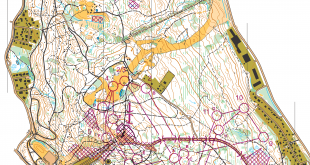
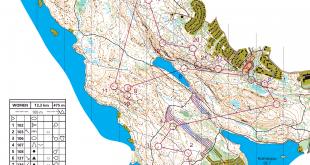
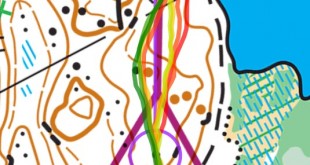
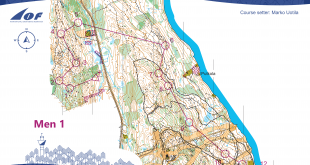
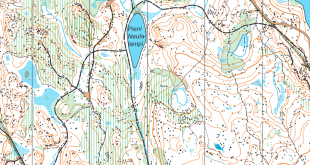
Key issues as far as I can see:
– because all options are printed it is all too easy to figure is other runners going to the same forking or not. So you are still running safely in pack, pack is just smaller.
– the control after spreading control is always common. So right after spreading control all runners you will see are going to same control, no need to navigate yourself.
– if you still somehow end up running alone or you are pack leader and navigating yourself, the distance you have to do it is quite short. From common control to spreading control and the beginning of the next leg to the point you’ll see runners from other forks: here it is about 200..600m. Even if faster athlete is 30 s/km faster (it’s not that huge in reality) he’ll be just 10..15 seconds ahead and slow one has fair changes to have visual contact after the spreading, at least to the last followers the fast pack. So effectively one needs to make mistake to loose contact.
– elite athletes doesn’t often mistakes if they look at the map/leg well and make plan ahead. Mistakes happens when they don’t plan or read map well. Here they have to choose between three option by looking at options. So they naturally have looked and have plan for the spreading leg they choose, makes fatal mistakes less likely.
As it is now it is pretty much doomed to fail. To make it work the next version should have workarounds for those issues. In short: athletes should not easily know if next control common or not, or will next control be same with other runners in the pack. This means there should be spreading all the time, several spreading controls in a row and other spreading alternatives should not be printed on one’s map. Then navigating independently would be essential and blind following would be very risky.
@jagge: ‘other spreading alternatives should not be printed on one’s map.’
Then it isn’t ‘runners choice’ anymore. The ‘choice’ is mandatory to justify unequal courses to a comparable result.
-> The test was a failure.
-> The method has several fundamental errors and there are more negative than positive effects (
– element of luck/unfairness in regard of the splitting effect and the unpredictability of the best choice
– unequal courses
– splitting groups into smaller groups or isolated runners
– transparent to the runner
– no real splitting effect on top runners
– no real splitting effect on ‘groups against groups’
– choice of other runners is readable by the following either at the punch or according to the run-away direction
– choice can be agreed beforehand for example inside the leading pack or inside a national team
– ‘not better’ than a butterfly
– there are no blind followers on this level
+ some action in the hour before the collective sprint at the run in :-P
->The method is an attempt to fig leafing the fact, that massstart and chasestart with a huge starterfield of top runners are boring formats with a low level of independant navigation as soon as bigger leading groups form (which is highliy likely; See even Hubmann and Gueorgiou catched at WC Liberec). In that perspective it is less a separating method but an argument against mass-&chasestart at the WOC. :-)
Well, having choice doesn’t mean all alternatives must be printed on one map. An example: http://www.routegadget.net/misc/2x4mapspreading.jpg Here athletes get four maps at start and they need to choose just one. At halfway there is map exchange, 4 new maps. Still runners choice. I am sure people behind runners choice can figure out better solutions than these, and are smart enough to test them properly in trainings and using it at national level races couple of years before saying anything about WOC.
One alternative would be letting team coaches to choose a course for each team member in advance. Like this there could be more course alternatives, like 25, competitors would never see other alternatives or memorize possible common controls, no need for course choosing on clock and no map exchanges. And naturally coaches would have to choose different course for each team member. Coaches already choose runners for each dicipline and runners fore realy legs, so they already have a big impact on final result. This would just slighly extend their role.
Or alternatively each team coach would sort those 25 maps, the favorite first, least favorite last. Runners would get a map based on this selecting rule:
Runner gets favorite map, unless (1) it is already taken by other team member (better placed in prologue), or (2) someone who starts inside one minute ahead has got that course. If course is not available, runner gets favorite #2, then #3 and so on. If none of the maps are available runner would get in similar way the map with least runners.
Like this there would/could be well enough spreading, and no one who starts inside one minute before or after is not expected to have same course (for example there could be 25 first controls). The best strategy would be navigating independently and race should be quite fun to run too. And note, a good course variation is selected by team coach and EARNED by running well in prologue. It makes it fair – one can blame only himself or coach for not getting the best course variation.
Course/spreading scheme would look for example something like this:
http://www.routegadget.net/misc/25map.png
There could be more spreading if it is needed, up to planner. It would still be easy enough to compare runners in GPS tracking and see who is leading.